Essential Guide to WordPress Maintenance Reports for Agencies
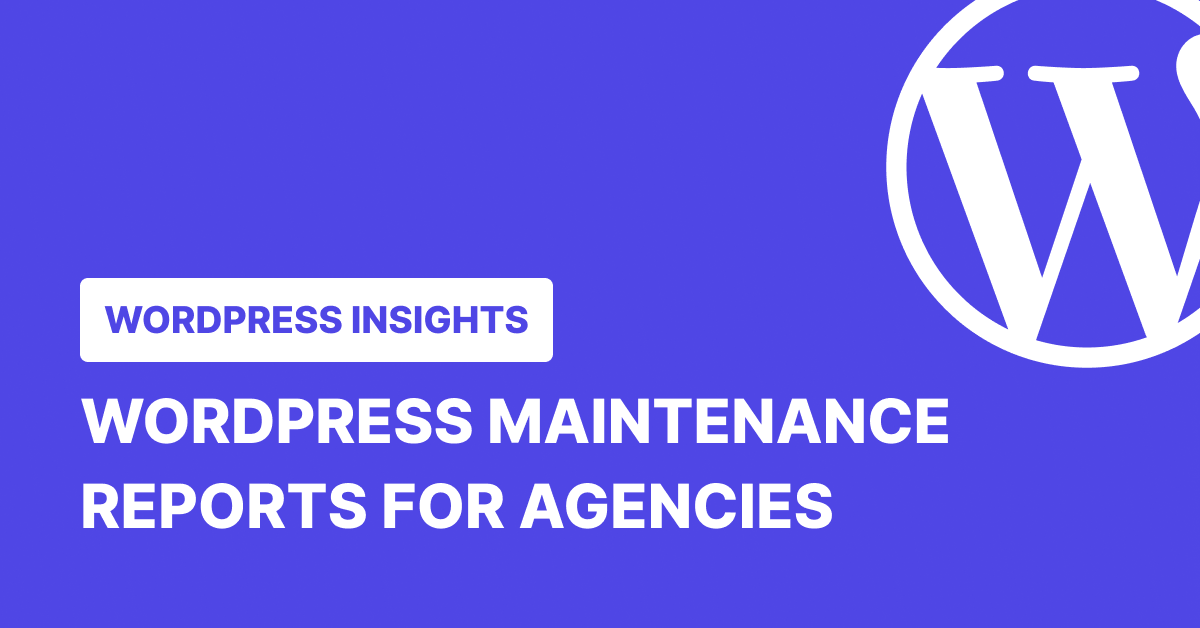
Key Highlights
- WordPress sites deteriorate gradually due to missed updates and unaddressed performance issues, not overnight failures.
- A one-second delay in page load time can reduce conversions by 7%, potentially costing businesses thousands in lost revenue.
- WordPress maintenance reports prove your value to clients by documenting updates, security patches, and performance improvements.
- Essential report elements include update history, performance metrics (uptime, load times), and security scan results.
- Automated reporting saves significant time compared to manual methods, especially when managing multiple client sites.
- WP Umbrella can set up automated reports in minutes that are delivered on schedule with your branding.
- Monthly reporting works best for most clients, striking a balance between keeping them informed and not overwhelming them.
Most WordPress sites don’t break overnight. They slowly fall apart due to missed updates, ignored security patches, and performance issues that go unnoticed.
Let’s put this in perspective: a one-second delay in page load time can drop conversions by 7%. If you’re running a shop that makes £500 a day, that slow page could cost you £13,000 a year.
For agency owners and freelancers managing client sites, a slow or broken website isn’t just embarrassing; it’s expensive. Your clients lose money, and you might lose them.
WordPress maintenance reports are your solutions to these problems. They help you spot issues early, track what’s working, and show clients exactly what they’re paying for.
So, what should a good report include? When should you send them? How do you make them quickly? These are some of the questions we’ll answer in this blog.
Why WordPress Maintenance Reports Matter for Agencies
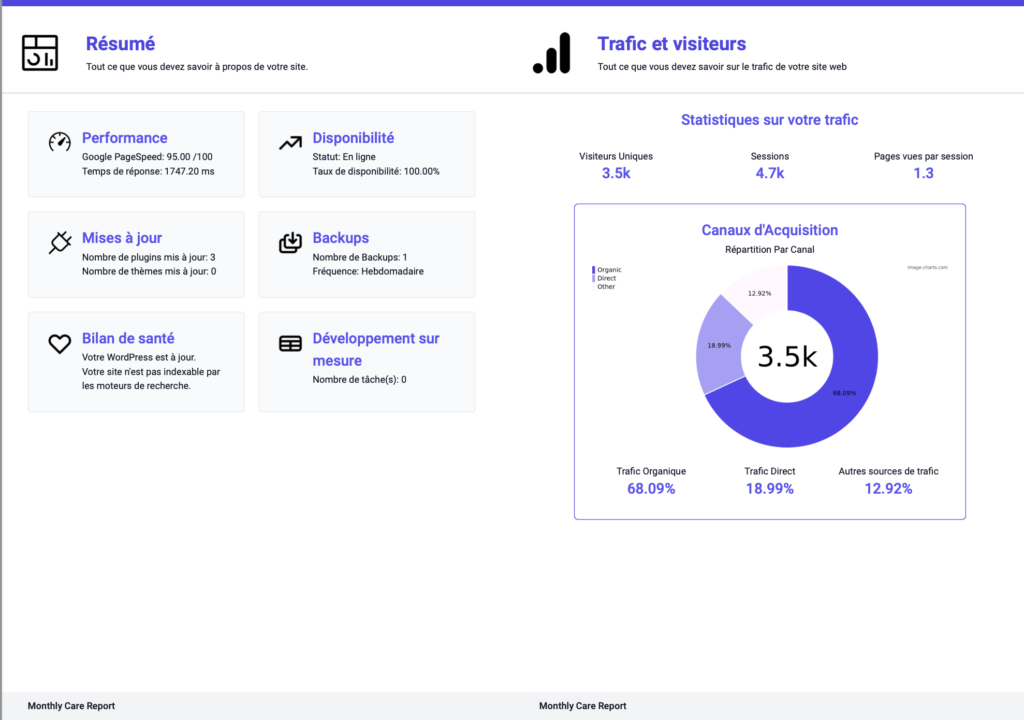
WordPress maintenance reports are proof of your work. When a site runs smoothly, clients often don’t notice the effort behind it. They might assume updates happen automatically or that security is just “built-in.” But when something breaks? That’s when questions start rolling in.
A maintenance report shows your value before there’s a problem. It provides a clear record of updates, security patches, backups, and performance improvements—so clients see what’s being done to protect and optimize their site.
- Builds Trust: When clients see a clear, data-backed record of their website’s maintenance, they feel more confident in your agency’s work.
- Keeps Clients in the Loop: A clear breakdown of updates and fixes helps clients see the value of your work.
- Showcases Expertise: Regular reporting highlights the depth of your service and what you bring to the table.
Key Elements of a WordPress Maintenance Report
A WordPress maintenance report should be clear, concise, and data-driven. Here are some of the things to include:
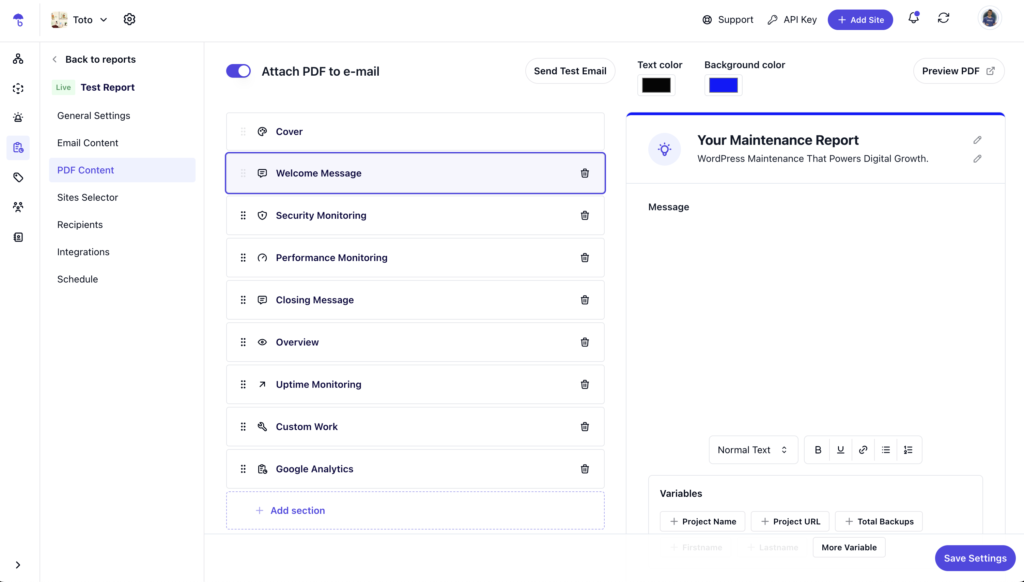
Update History
Clients often don’t realize how many updates happen behind the scenes. WordPress core updates, plugin updates, and manual fixes keep their site secure, functional, and optimized. Without reporting, they may not see the effort involved. Here are things you must include in your maintenance report:
- WordPress core updates applied
- Plugin and theme updates completed
- Any customizations or manual fixes
Performance Metrics
Speed and uptime directly impact user experience, SEO rankings, and conversions. If a client’s website is slow or down frequently, they’re losing potential customers.Without these reports, clients may not realize the direct link between website performance and business success.
- Uptime and performance
- Load time reports and site speed improvements
- Backup status
Security and Maintenance
Many clients don’t understand the risks of malware, hacking attempts, or outdated software. Security updates might seem invisible, but they’re crucial for site integrity. Without security reporting, clients might assume their website is “safe by default” and underestimate the work involved in keeping it that way. Always include:
- Security scan results
- Malware removal or security fixes
- Any additional maintenance work
Manually tracking updates, uptime, and security issues takes time. And if you’re managing multiple sites, it’s easy to miss something important. That’s where tools like WP Umbrella come in. They automate updates, monitor site performance, and handle security scans—so you don’t have to. More on that later in this article.
Related: Read our ultimate WordPress website maintenance checklist for 2025
Manual Reports vs. Automated Reports
So, should WordPress maintenance reporting be manual or automated?
Automation is almost always the better choice; it saves time, reduces errors, and makes tasks more manageable. WordPress maintenance reports are no different. Here are the top three advantages:
Time: Manually collecting data from different platforms and formatting reports takes hours. If you’re managing multiple sites, that’s time you could spend on more significant tasks. Automated reporting handles the heavy lifting, so you don’t have to.
Accuracy: Mistakes in reports can cost you a client’s trust. When you pull data manually, it’s easy to miss something or make an error. Automation ensures reports are always accurate, consistent, and reliable—no last-minute scrambling, no guesswork.
Scaling Up: More clients mean more reports. Doing them by hand doesn’t just slow you down—it makes scaling up harder. Automated reporting lets you keep up without extra effort. Whether you manage five sites or fifty, the process stays smooth.
Automate WordPress Maintenance Reports with WP Umbrella
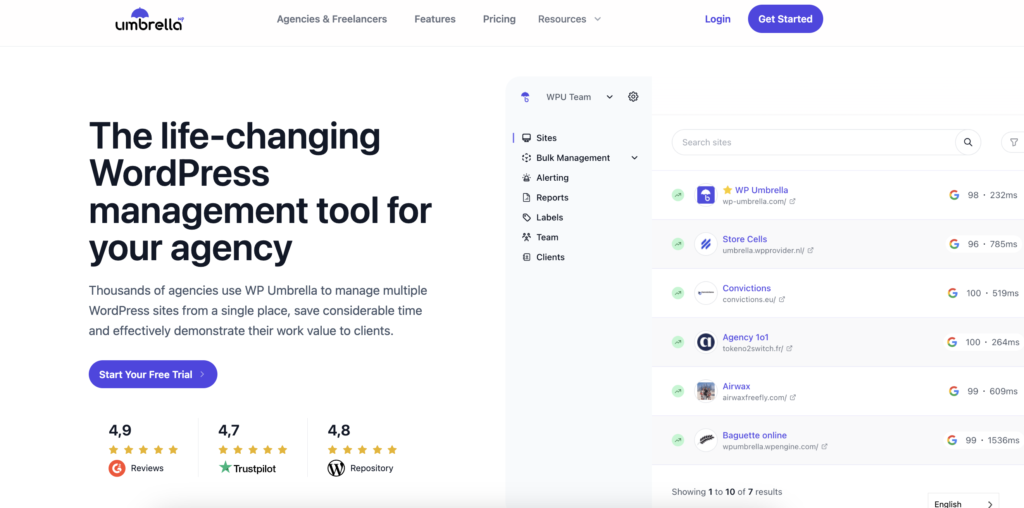
Manually creating maintenance reports takes time. WP Umbrella automates everything, so you’re not stuck copying data or formatting documents. Here’s a brief overview of its maintenance reports
Setting Up Your First Report
This takes a few minutes minutes:

Click Reports
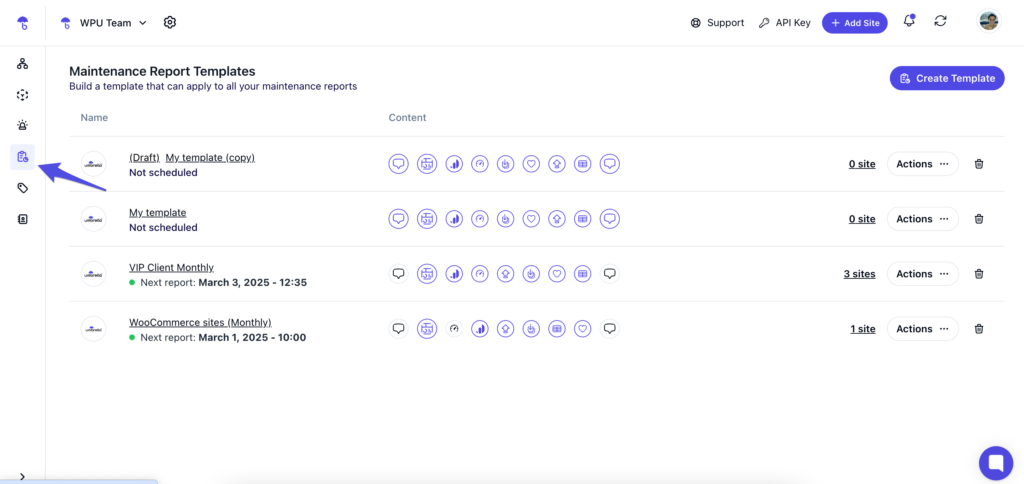
Next, click Create Template
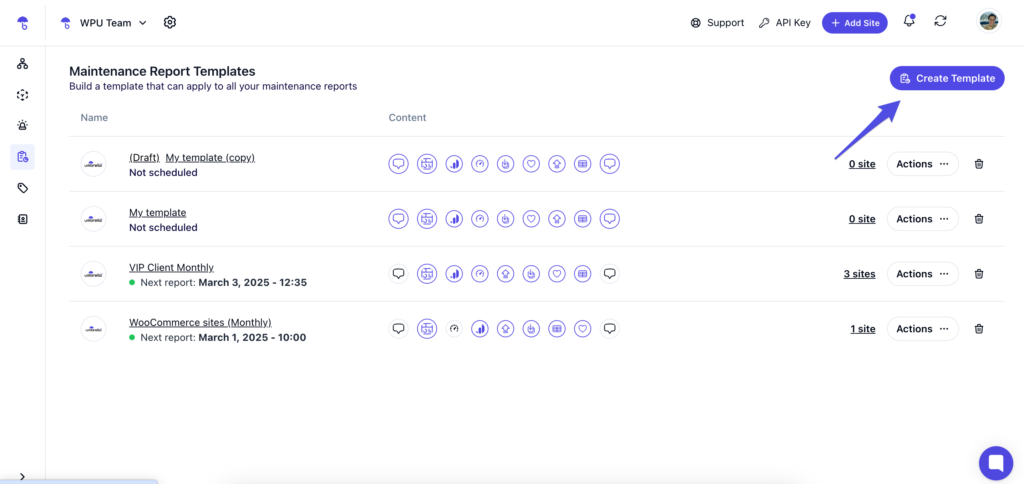
Pick what to include. WP Umbrella offers various options to fully customize your reports. Choose from general settings and click Save and Continue.

Similarly, customize all the settings, including content, email, automation, and that’s it. Once it’s set, WP Umbrella runs on autopilot. The reports go out automatically, with all your client’s details filled in—their name, website, and company info. Every report looks custom-made and delivered like clockwork.
New Reporting Feature Coming Soon
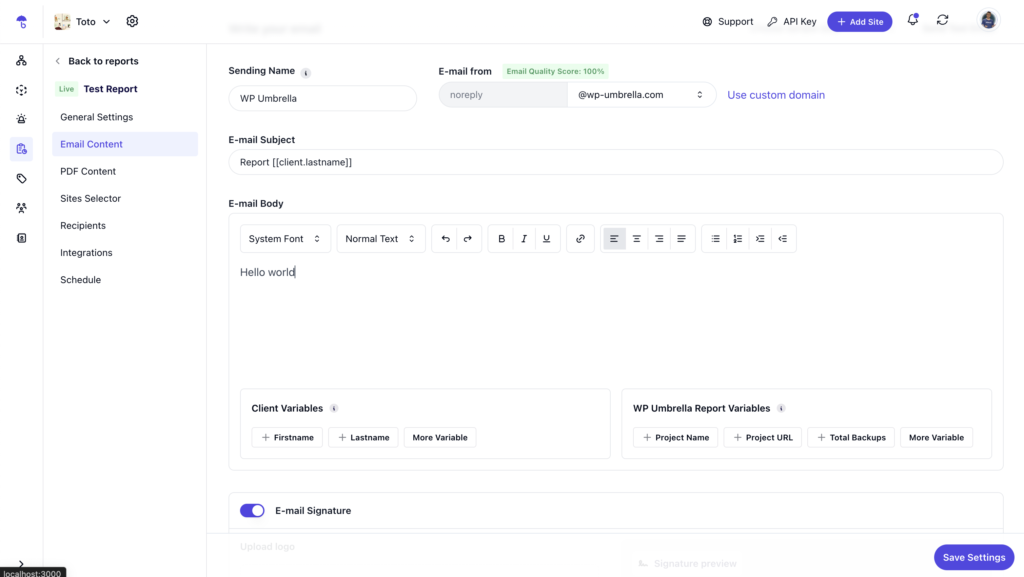
Watch out this space for more details!
Brand It as Your Own
Make the reports truly yours with WP Umbrella’s white labeling. Add your logo, send emails from your domain, and match your brand’s look so it looks like it came straight from you.
How Much Time Will This Save You?
Most agencies spend hours pulling together maintenance reports. Let’s say you manage 10 clients and spend an hour per report. That’s 10 hours gone every month. WP Umbrella cuts that down to minutes.
Your clients get detailed, professional reports on schedule. You get time back to focus on real work. It’s definitely better than spending hours formatting spreadsheets.
Start Sending Professional Reports Today!
Get your first client report set up in minutes with WP Umbrella. Stop wasting hours on manual reporting and show clients the value of your work!
Get Started for free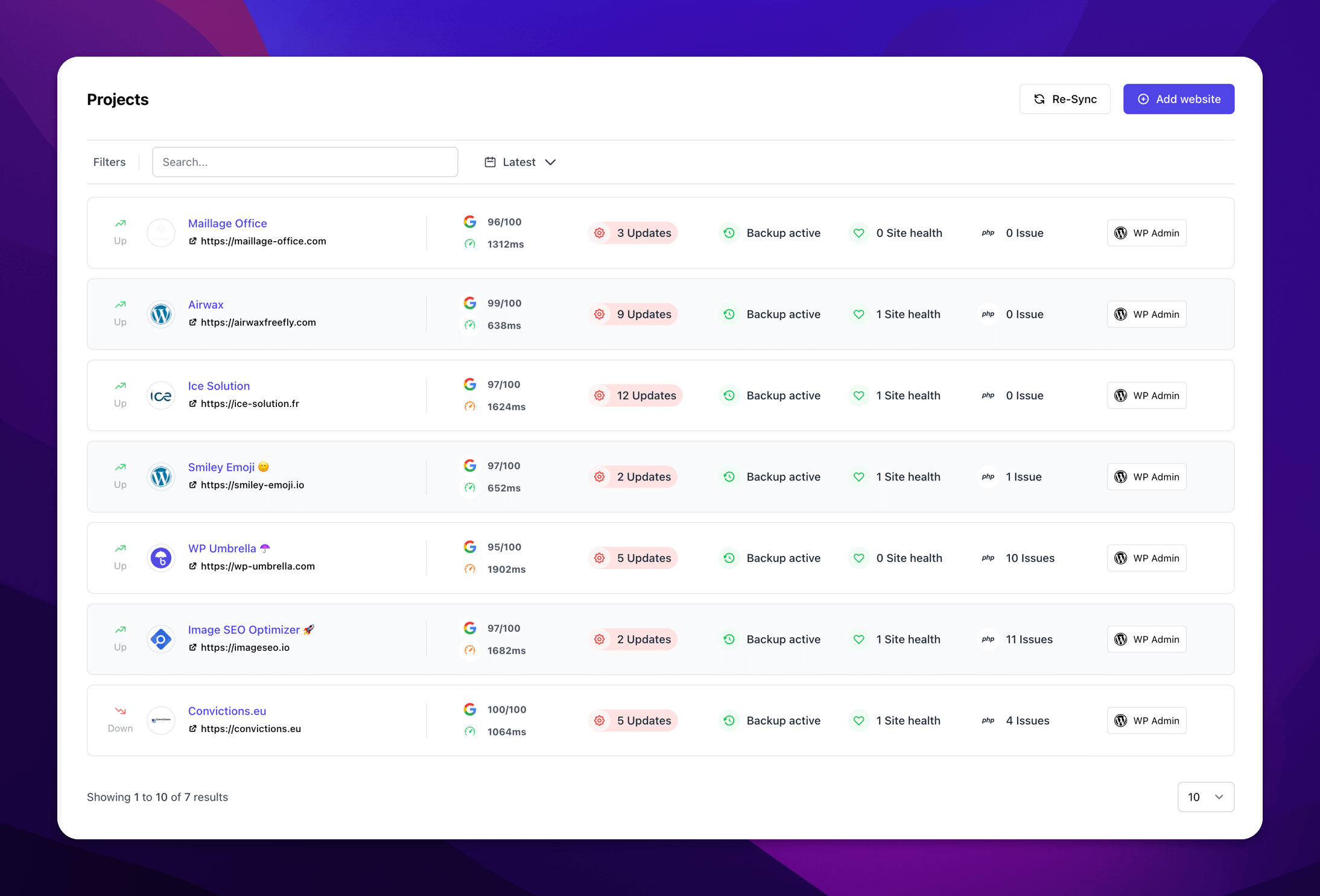
Best Practices for Generating WordPress Maintenance Reports
Automating reports is easy. But if they’re packed with useless data, clients won’t read them. Here’s how to keep them clear, useful, and actually worth sending.
Stick to What Matters
Clients don’t need a play-by-play of every update. Show them uptime, security, backups, and key changes that impact their site. If a report is full of technical jargon, they’ll ignore it.
Make Important Stuff Obvious
Did the site go down? Was a security issue fixed? Highlight it. Clients should see what changed in seconds—not dig through pages of data.
Explain Why It Matters
Saying “Optimized CSS and JavaScript files” means nothing to most clients. Instead, say, “Your site now loads 25% faster, which means visitors are less likely to leave.” Connect the work you’ve done to tangible business outcomes.
Show, Don’t Just Tell
A picture isn’t just worth a thousand words—it’s worth your client actually paying attention. We process visuals 60,000 times faster than text, so don’t just tell—show. A simple chart comparing load times before and after optimization says more than a wall of text ever could.
Be Honest About Issues
Don’t hide if a site goes down or has a security risk. Clients will find out eventually. Tell them what happened, what you did to fix it, and how to prevent it in the future.
Make It Personal (Without Extra Work)
Generic reports feel… well, generic. WP Umbrella lets you auto-fill client names, business details, and site info, so every report feels custom—without you lifting a finger.
End With What’s Next
A report that just lists what’s been done is fine. A report that tells clients what they should do next is better. If they need to approve updates or consider new security measures, tell them.
Send It on Time, Every Time
Reports should go out on schedule, whether weekly, monthly, or something else. If clients don’t hear from you, they’ll assume nothing is happening.
Conclusion: Mastering WordPress Maintenance Reports
A maintenance report is proof of the work you’ve done and a reminder to clients that their site is in good hands. Keep reports simple, focus on what matters, and let automation do the heavy lifting. The less time you spend formatting reports, the more time you have to grow your business.
Frequently Asked Questions
For most clients, a monthly report works best. It keeps them informed without overwhelming them. If a site has frequent updates or higher security risks, bi-weekly reports might be a better fit.
Tools like WP Umbrella automate reporting, track performance, and monitor security. It also integrates with Google Analytics, so clients can see key website metrics alongside their maintenance updates—all in one report.
It depends on the client. While not always necessary, including costs for premium plugins, additional security measures, or extra work helps clients see the value of their investment. If they’re paying for ongoing maintenance, showing the ROI—whether it’s avoided downtime, better performance, or fewer security issues—makes it clear why your service is worth it.
Yes, and you should. Manually compiling reports wastes time, especially if you’re managing multiple sites. Tools like WP Umbrella let you set up automatic reports that pull in data on updates, security, uptime, backups, and site performance. Once set up, reports go out on schedule so clients stay informed without you spending hours formatting data. And if you need a report immediately, you can skip the automation and generate one manually.
